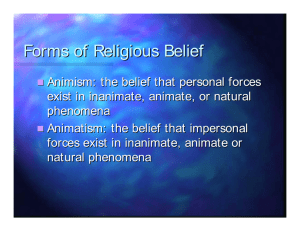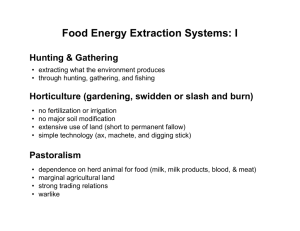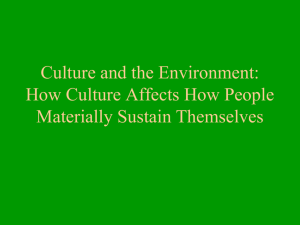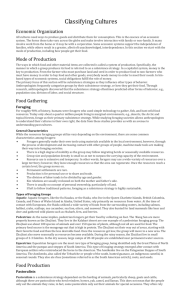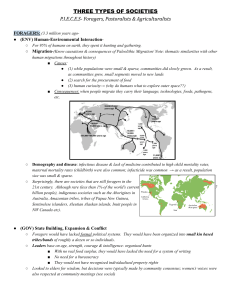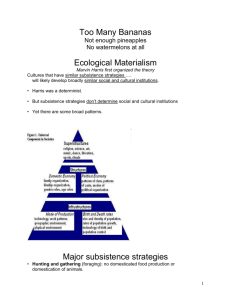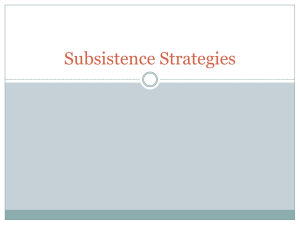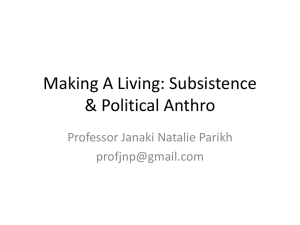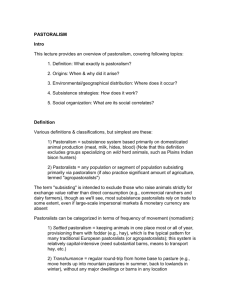Horticulturalists, Agriculturalists & Industrialists
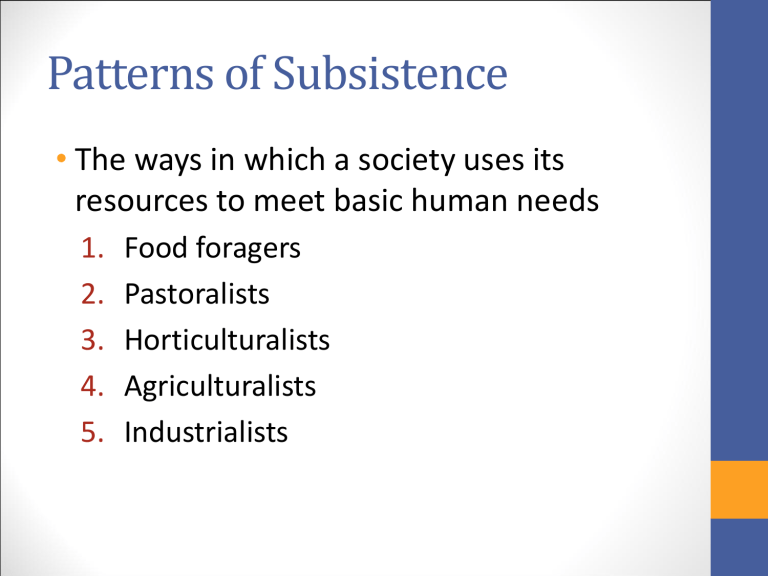
Patterns of Subsistence
• The ways in which a society uses its resources to meet basic human needs
1.
Food foragers
2.
Pastoralists
3.
Horticulturalists
4.
Agriculturalists
5.
Industrialists
Adaptation
• The process by which humans develop ways of doing things that are compatible with the resources they have available to them and within the limitations of the environment in which they live
Cultural Adaptation:
Technology
• The knowledge, practices & tools a group has developed to help them adapt to the physical environment a.
Producing food & goods b.
Constructing shelter, clothes, tools c.
Distributing resources d.
Transporting people & goods
Division of Labor
• Assignment of specific productive tasks to particular individuals within a society
• Exists in all societies
• Always based on gender & age
• Efficient way to get things done
Gender Division of Labor
• Not always as fixed as it may appear
• Men & women may do opposite gender activities at certain times
• Restrictions on gendered labor may be ignored in practice (real vs. ideal)
• Conditions originally creating it may change
• Complex combination of biological & cultural factors
Age Division of Labor
• Age specific tasks/activities
• Varies cross-culturally
• Culture determines age appropriate work & expectations
Subsistence Strategies
• Understanding of the variations in human societies as they adapt in different ways to different environments
• is both biological & cultural
• Carrying capacity – max # of people a particular society can support given available resources
• Strategy depends on environment, technology & way of life
Subsistence Groups: Foragers
• Aka “Hunting & Gathering” societies – based on hunting, fishing & gathering of edible plants, nuts, roots
• Gathered foods make up 70-80% of diet
• Meat highly valued
• Wide variety of environments: semi-desert, tropical forests, polar regions
• Characterized by flexibility & mobility
Foragers, Cont.
1.
Low population densities a.
Must live below carrying capacity b.
Are spread out c.
Least impact on environment
2.
Nomadic or semi-nomadic a.
Limited technology & material possessions
3.
Social organization based on family or bands (groups of families/kin) a.
May have headman or headwoman who serves as leader/coordinator; but no real power b.
No formal political structure
Foragers, Cont.
c.
Egalitarian – resources, decision making is shared equally (through leveling mechanisms)
4.
Division of Labor – occupational specialization but gender complementarity a.
Men hunt, women gather – but is fluid & activities overlap (may be rigid, may be loose)
5.
Gender relations – gender equality a.
Men/Women equally valued, have equal rights
Foragers, Cont.
6.
Changes – modern technology, wage work (mostly for men), attempts to settle & incorporate into state, contact with other cultural groups a.
Major effect on gender relations
Men contribute more labor & food
More rigidly defined work activities
Women’s decision making power declined
Men/women occupy separate spheres
Men acquire more social prestige
Less egalitarian (within & between families & bands)
Subsistence Groups:
Pastoralists
• Aka Animal Husbandry – based on herding, breeding & consuming domesticated herd animals (camels, sheep, goats, horses, llamas, yaks
& reindeer)
• Herds extremely valuable (economically & for social reasons)
• Diet based on animal foods (blood, milk, some meat)
• Dung for fuel, bones for tools, skin for clothing & shelter
• Tend to keep small gardens & trade important
• Wide variation in types of animals kept & how herded (tend to specialize)
Pastoralists, cont.
• Usually ecologically sound – must sustain pasture lands & intensive use of animals means little waste
1.
Geographic mobility a.
Transhumance – seasonal movement between upland & lowland pastures b.
Nomadism – migration & relocation of whole villages c.
Small, dispersed camps d.
Technology & material possessions limited
Pastoralists, Cont.
2.
Division of Labor – occupational specialization a.
Boys & men tend herds b.
Women & young girls tend household & make products from dairy of herds
3.
Social Organization – gender segregation due to Div. of Labor a.
Men/boys in herding camps – may be away from home for days b.
Women/girls in huts
Pastoralists, Cont.
c.
Large herds sign of wealth
Needed for bride price, used as sacrifice to gods/ancestors, used to solidify social bonds (between men & families)
4.
Gender Relations – tend to be male dominant (patrilineal, patrilocal) a.
Greater social/economic value linked to men due to association with herd animals
Pastoralists, Cont.
• Changes – due to colonization, settlement
• Wage work for men has led to:
• Increased economic power & decision making for men with devaluation of women’s roles/tasks
• Very restrictive of women
• Contact with other cultures – cultural tourism
Food producing societies
• Transition from food collection to food production around 10,000 ya
• Earliest known plant & animal domestication in the “Fertile
Crescent” in Middle East
• Led to population explosion
• Children become valuable source of labor; family size increases
• Property rights; more formalized systems of organization
• Development of specialists
• Increased social inequality
Horticulturalists
• Aka Subsistence agriculture – based on cultivation of crops for self-consumption
• Small scale, low intensity farming on small plots
• Basic hand tools (hoe, digging sticks)
• Limited, if any, surplus
• Rely heavily on natural variables (sunlight, water, soil)
• Small domesticated animals for food
Horticulturalists, Cont.
1.
Slash & burn (Swidden) cultivation a.
Manual clearing of land – cutting down growth, burning it, ash serves as fertilizer b.
Management of soil fertility through field rotation, fallowing (not planting & allowing natural vegetation to be restored) c.
Eventual movement to other fields d.
Control over/alteration of environment, but generally not damaging or permanent
Horticulturalists, Cont.
2.
Cultivate a variety of crops a.
Continuous food supply b.
Mirrors natural bio-diversity
3.
Division of Labor – tends to be sharper, but contributions of both genders & the young valued a.
Men & boys clear & prep fields; Women plant & harvest; children help harvest
Horticulturalists, cont.
4.
More sedentary lifestyle a.
More time/energy devoted to construction of dwellings b.
Accumulation of material goods increases c.
Population density increases
5.
Social Organization – more complex (related to ownership of land, crops, animals) a.
More formalized system for regulating, protecting & resolving issues b.
Status differences emerge – ownership/control over land
Horticulturalists, cont.
5.
Social Org. – Cont.
c.
Kinship based
• Multi-family kin groups (clans or lineages)
• Revolve around inheritance of land
• Patrilineal or Matrilineal
• Cooperation & coordination of cultivation activities
Agriculturalists
• Aka Intensive agriculture – based on large scale production practices using irrigation, fertilization, draft animals & machinery
• Most prevalent subsistence pattern
• Archaeological evidence for first intensive ag societies in Egypt,
Mesopotamia (Iraq, Syria), India, Pakistan, northern China,
Mesoamerica & western S. America (world’s first great
civilizations)
Agriculturalists, cont.
• Characterized by specialization in one or a few crops
• Production of surplus
1.
Specialization & Diversification of Labor a.
Requires organized labor for construction & maintenance of irrigation systems b.
Not everyone engaged in subsistence activities c.
Skilled tasks such as engineering, tool making & repair, other technological innovations appear
Agriculturalists, cont.
2.
Increase in population = development of non-industrial cities a.
More settled communities
3.
Centralized & formal political systems a.
Protect rights to land, resources; resolve conflicts b.
Chiefdoms or state society
4.
Social organization – differential access to land & resources create more stratified society
Agriculturalists, cont.
a.
Social classes develop (nobles vs. commoners) b.
Elite class may rise to power (owners of means of production) c.
Kinship very strictly defined
• Inheritance
• Cooperation, coordination, increase wealth & status
• Tend to be patrilineal (limits women’s access to & ownership of land)
5.
Division of Labor – men prep land, maintain equipment, harvest; women plant, weed, harvest & do food prep & processing
http://topdocumentaryfilms.com/one-day-life-rice-farmer/
Industrialized society
Characterized by increases in:
1.
Control over & alteration of environment a.
Technological extraction of resources (mining, deforestation, dams,
“fracking”
2.
Mechanization of labor & production a.
Reliance on non-renewable resources for industrialization & increasingly mobile population b.
Mass production of food & material goods
3.
Density of urban life a.
Rural to urban migration
4.
Social & geographical mobility a.
Movement from place to place in search of shifting resources (i.e. jobs)
Industrialized society
b.
Opportunities for socio-economic mobility increase c.
Ties to family (kin) & place weakening
5.
Specialization of labor a.
More individualized b.
Gender division of labor less, but increase in occupational specialization
6.
Integration of supply & service networks (communication, transportation, processing) a.
Infrastructure
7.
“Portable religion” – linkage to one of major religious traditions
(providing sense of continuity, community, identity)
Industrial agriculture
• Production relies on technological sources of energy (rather than human/animal energy)
• Machinery & technology needed are expensive; fuel costs high
• Rise of agri-business
• Mono-culture specialization: large-scale single commodity production
• Commercialization: processing, transporting, marketing
INDUSTRIALIZED
PRODUCTION
Advantages: Is very productive (both food & non food items), standard of living improved, opportunities for socio-economic mobility increased
Disadvantages: very high cost
• Displacement of small family farmers
• Toxic runoff/pollution from manufacturing & industrial ag production
• Environmental degradation
• Wealth, power VERY concentrated (1%)
